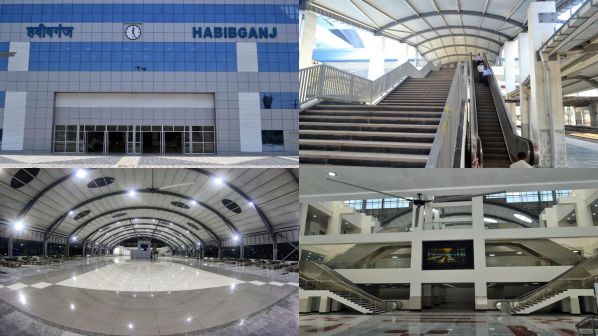Government Unveils Grand Plan for Railway Station Redevelopment Across States and Union Territories

Government Unveils Grand Plan for Railway Station Redevelopment Across States and Union Territories
In a groundbreaking move aimed at modernizing and enhancing the infrastructure of the Indian Railways, the government has recently announced an ambitious list of States and Union Territories (UTs) where railway stations are set to undergo a remarkable transformation through comprehensive redevelopment. This monumental initiative is expected to not only elevate the overall passenger experience but also contribute to economic growth and development on a regional scale.
The power-packed list, disclosed by the authorities, includes an array of stations that are earmarked for this transformative process. These stations, strategically chosen across different corners of the country, are poised to be upgraded to meet the evolving needs of passengers and visitors while simultaneously adding a touch of modernity and efficiency.
With the announcement of this visionary project, the government has signaled its commitment to revitalizing the nation’s railway infrastructure and ensuring that railway stations transcend being mere transit points to become vibrant hubs of activity. The redevelopment plan aligns seamlessly with the larger objective of fostering economic growth by creating jobs, boosting tourism, and stimulating local businesses.

One of the central tenets of this redevelopment initiative is to introduce world-class amenities and facilities to railway stations that are often perceived as conventional and utilitarian spaces. The ambitious plan encompasses the overhaul of waiting lounges, platforms, ticketing services, and passenger conveniences, with the aim of providing a more comfortable and enjoyable experience to travelers. Such enhancements are poised to make railway stations more inviting and conducive to leisurely visits, thereby promoting rail travel as a preferred mode of transportation.
This transformative endeavor isn’t solely limited to cosmetic changes. A robust technological overhaul is also at the heart of the redevelopment project. High-speed Wi-Fi connectivity, improved security infrastructure, and the integration of digital services are among the innovative measures set to be introduced. By fostering a digital-first approach, the government seeks to align railway stations with the modern world and the demands of an increasingly tech-savvy population.
The comprehensive list of States and UTs that have been chosen for railway station redevelopment reflects a balanced approach that spans across geographical regions and economic strata. From bustling urban centers to serene rural landscapes, the initiative aims to uplift railway stations across the spectrum, thereby leaving no traveler untouched by its positive impact.
The inclusion of stations from various States and UTs also underlines the cooperative nature of this endeavor. By collaborating with regional governments and local authorities, the central government is paving the way for a truly inclusive transformation that is tailored to the unique needs and aspirations of each region. This cooperative spirit is poised to not only expedite the redevelopment process but also foster a sense of ownership and pride among local communities.

As the wheels of progress begin to turn, the project is set to unleash a cascade of benefits for all stakeholders involved. For travelers, the rejuvenated railway stations promise an upgraded travel experience that seamlessly blends comfort and convenience. Local businesses, too, are set to reap the rewards of increased footfall and economic activity, which can potentially breathe new life into the surrounding areas.
Furthermore, this ambitious undertaking is expected to generate significant employment opportunities. As construction, maintenance, and operation of the redeveloped stations demand a diverse set of skills, the initiative has the potential to provide jobs for a wide spectrum of individuals, ranging from skilled labor to technology specialists. This injection of employment opportunities is well-timed, given the current economic climate and the nation’s pursuit of job creation.
The timing of this announcement also speaks volumes about the government’s vision for the future. As the world grapples with the challenges posed by climate change and the imperative to transition towards sustainable modes of living, the railway station redevelopment project holds the promise of aligning with these ideals. By integrating eco-friendly technologies and sustainable design practices, the stations are poised to become models of environmentally conscious infrastructure.

The impact of this railway station redevelopment initiative extends beyond immediate upgrades and enhancements. By creating modern, well-equipped hubs of transportation, the government is also fostering a sense of national pride and identity. These reimagined stations will serve as symbols of India’s commitment to progress, innovation, and inclusivity. They will stand as testaments to the nation’s ability to embrace change while preserving its rich cultural heritage.
Moreover, the redevelopment project is set to create a ripple effect that extends to sectors beyond transportation. As railway stations become more attractive and accessible, they are likely to encourage intermodal transportation, seamlessly connecting trains with other modes of travel, such as buses, metro systems, and even cycling networks. This holistic approach has the potential to alleviate urban congestion, reduce pollution levels, and provide a more sustainable transportation ecosystem.
In the process of redefining railway stations as modern centers of activity, the government is actively contributing to the growth of the hospitality and retail sectors. The redevelopment plan includes provisions for retail spaces, eateries, and entertainment options within the stations.
This not only enhances the passenger experience but also offers local businesses an opportunity to thrive. The inclusion of these commercial elements can potentially transform railway stations into lively, vibrant spaces that serve as more than just transit points.
Beyond the tangible outcomes of infrastructure upgrades and economic growth, the railway station redevelopment initiative is a testament to the government’s commitment to inclusive development. By selecting stations from diverse geographical and economic backgrounds, the government is ensuring that no region is left behind in the journey towards progress. This approach not only bridges the gap between urban and rural areas but also aligns with the broader vision of equitable growth and prosperity for all citizens.
In conclusion, the government’s visionary railway station redevelopment project is poised to make an indelible mark on India’s transportation landscape. With a comprehensive approach that encompasses technological innovation, economic growth, sustainability, and inclusivity, this initiative has the potential to redefine the role of railway stations in the nation’s narrative. As the transformation takes shape, each redeveloped station will stand as a testament to the power of collective effort, forward-thinking strategies, and a commitment to a brighter future.




